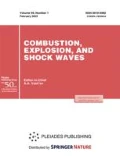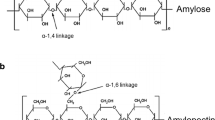Abstract
The kinetics of devolatilization of some foodstuff materials like white wheat flour, sugar, and cocoa powders are studied by using thermogravimetric analysis, in order to measure their pyrolysis rate. The mean pyrolysis rate of these materials is used as a criterion to predict their explosivity. A comparison of the mean pyrolysis rates shows that the sugar powder is the most explosive material among others. Wheat flour explosivity is very close to sugar, and cocoa powder has the least tendency to explode. Our results are completely compatible with National Fire Protection Association reports.
Similar content being viewed by others
References
C. Proust, “Dust Explosions in Pipes: A Review,” J. Loss Prevent. Process Ind. 9, 267–277 (1996).
National Fire Protection Association (NFPA). Industrial Fire Hazards Handbook (NFPA Inc., 1990).
T. Abbasi and S. A. Abbasi, “Dust Explosions-Cases, Causes, Consequences, and Control,” J. Hazard. Mater. 140, 7–44 (2007).
National Fire Protection Association (NFPA). NFPA 61: Standard for the Prevention of Fires and Dust Explosions in Agricultural and Food Processing Facilities (2013); www.nfpa.org.
M. Bidabadi and A. Rahbari, “Modeling Combustion of Lycopodium Particles by Considering the Temperature Difference between the Gas and the Particles,” Fiz. Goreniya Vzryva 45(3), 49–57 (2009) [Combust., Expl., Shock Wave 45 (3), 278–285 (2009)].
M. Bidabadi, A. Haghiri, and A. Rahbari, “The Effect of Lewis and Damkohler Numbers on the Flame Propagation through Micro-Organic Dust Particles,” Int. J. Therm. Sci. 49, 534–542 (2010).
A. Haghiri and M. Bidabadi, “Modeling of Laminar Flame Propagation through Organic Dust Cloud with Thermal Radiation Effect,” Int. J. Therm. Sci. 49, 1446–1456 (2010).
M. Bidabadi and A. Rahbari, “Novel Analytical Model for Predicting the Combustion Characteristics of Premixed Flame Propagation in Lycopodium Dust Particles,” J. Mech. Sci. Technol. 23, 2417–2423 (2009).
J. Rath and G. Staudinger, “Cracking Reactions of Tar from Pyrolysis of Spruce Wood,” Fuel 80, 1379–1389 (2001).
Q. Dung Tran and C. Rai, “A Kinetic Model for Pyrolysis of Douglas Fir Bark,” Fuel 57, 293–298 (1978).
C. D. Doyle, “Series Approximations to the Equation of Thermogravimetric Data,” Nature 207, 290–291 (1965).
J. H. Flynn, “The ‘temperature integral’—Its Use and Abuse,” Thermochim. Acta 300, 83–92 (1997).
S. Vyazovkin and C. A. Wight, “Model-Free and Model-Fitting Approaches to Kinetic Analysis of Isothermal and Nonisothermal Data,” Thermochim. Acta 340, 53–89 (1999).
K. Slopiecka, P. Bartocci, and F. Fantozzi, “Thermogravimetric Analysis and Kinetic Study of Poplar Wood Pyrolysis,” Appl. Energy 97, 491–497 (2012).
L. Zhou, Y. Wang, Q. Huang, and J. Cai, “Thermogravimetric Characteristics and Kinetic of Plastic and Biomass Blends Co-Pyrolysis,” Fuel Proces. Technol. 87, 963–969 (2006).
E. Kastanaki, D. Vamvuka, P. Grammelis, and E. Kakaras, “Thermogravimetric Studies of the Ehavior of Lignite-Biomass Blends During Devolatilization,” Fuel Proces. Technol. 77–78, 159–166 (2002).
R. J. Evans and T. A. Milne, “Molecular Characterization of the Pyrolysis of Biomass. 1. Fundaments,” Energy Fuels. 1, 123–137 (1987).
G. Várhegyi, M. J. Antal, T. Szekely, F. Till, and E. Jakab, “Simultaneous Thermogravimetric-mass Spectrometric Studies of the Thermal Decomposition of Biopolymers. 1. Avicel Cellulose in the Presence and Absence of Catalysts,” Energy Fuels 2, 267–272 (1988).
G. Várhegyi, M. J. Antal, T. Szekely, F. Till, and E. Jakab, “Simultaneous Thermogravimetric-mass Spectrometric Studies of the Thermal Decomposition of Biopolymers. 2. Sugar Cane Bagasse in the Presence and Absence of Catalysts,” Energy Fuels 2, 273–277 (1988).
O. S. Han, M. Yashima, T. Matsuda, H. Matsui, A. Miyake, and T. Ogawa, “Behavior of Flames Propagating through Lycopodium Dust Clouds in a Vertical Dust,” J. Loss Prevent. Process Ind. 13, 449–457 (2000).
Z. Zivcova, E. Gregorova, and W. Pabst, “Porous Alumina Ceramics Produced with Lycopodium Spores as Pore-Forming Agents,” J. Mater. Sci. 42, 8760–8764 (2007).
W. E. Mason and M. J. G. Wilson, “Laminar Flame of Lycopodium Dust in Air,” Combust. Flame 11, 195–200 (1967).
R. K. Eckhoff, Dust Explosions in the Process Industries (Butterworth Heinemann, Oxford, 1997).
Author information
Authors and Affiliations
Corresponding author
Additional information
Original Russian Text © H.Beidaghy Dizaji, F.Faraji Dizaji, and M. Bidabadi.
Published in Fizika Goreniya i Vzryva, Vol. 50, No. 4, pp. 92–101, July–August, 2014.
Rights and permissions
About this article
Cite this article
Beidaghy Dizaji, H., Faraji Dizaji, F. & Bidabadi, M. Determining thermo-kinetic constants in order to classify explosivity of foodstuffs. Combust Explos Shock Waves 50, 454–462 (2014). https://doi.org/10.1134/S0010508214040145
Received:
Revised:
Published:
Issue Date:
DOI: https://doi.org/10.1134/S0010508214040145




